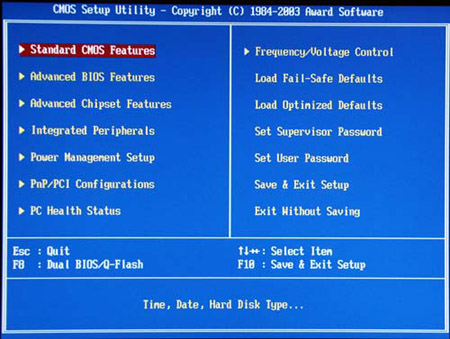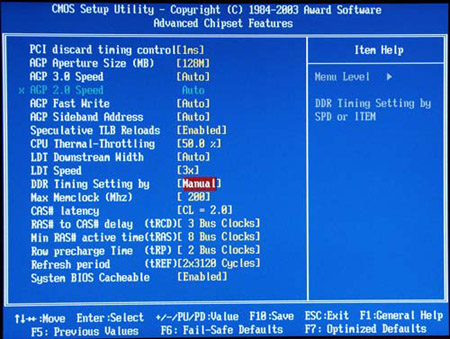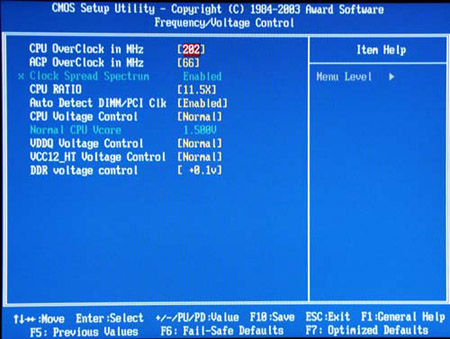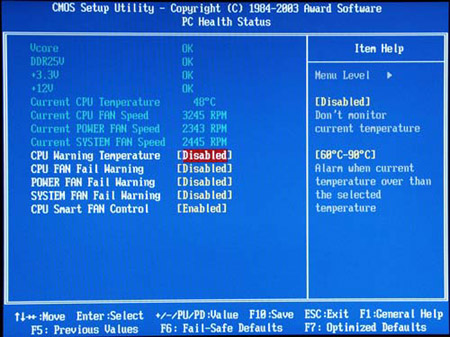Gigabyte K8NNXP-940: Built on Athlon64 FX51 Strengths
by Wesley Fink on October 9, 2003 11:52 PM EST- Posted in
- Motherboards
Gigabyte K8NNXP-940: BIOS and Overclocking
When we first looked at the Gigabyte pre-release BIOS, we were frankly disappointed. The board did not yield much better performance than the Athlon64 boards we had tested and it was missing the multiplier-unlocking feature. What a difference when we received the shipping F1 BIOS, which managed dramatic leaps in performance and the best Multiplier or Ratio settings that we have seen on an Athlon64 FX board. Considering that this is the first “release” version of the Gigabyte BIOS, we are looking forward to what additional performance Gigabyte may be able to coax from this board in future BIOS revisions.
The K8NNXP-940 uses the familiar Award BIOS, though it will take us all a while to get used to the new options available on HyperTransport boards. Gigabyte also leaves memory timings off their basic BIOS screen, as they have on other recently-released boards.

The Advanced Chipset Features are there — hidden — and you have to enter BIOS with DEL, then hit CTRL+F1 to bring up the hidden menu. We understand why Gigabyte might choose to do this on mainstream boards, but no one would ever accuse the expensive FX51, which requires expensive Registered memory, of being a mainstream choice. Users who will buy the K8NNXP-940 are enthusiasts, and they hardly need to be protected from themselves with a hidden memory timings menu. Gigabyte really needs to rethink this annoying feature, because all it does is create confusion.

Once you have found the Advanced Chipset Features, you will see a complete selection of memory-tweaking options. The LDT option allows changing Hypertransport speed, and we suggest you leave it alone. When we set LDT to 4.0 (800/1600), it promptly locked the system on reboot. Memory can be left at Auto, which reads the SPD and sets timings, or you can force a memory speed of 100, 133, 150, 166, or 200 representing DDR200 to DDR400.

Advanced BIOS Features is a collection of the more common BIOS controls. After initial setup, you will likely see this menu only if you have multiple boot devices, and need to make changes to Boot Order.

The Frequency/Voltage Control section is where CPU FSB (actually HT speed), CPU multipliers and voltages are set. You can also set AGP/PCI speed in 1MHz increments from 66 to 100. The available voltage options and ranges are what we expect, but have rarely found, on FX boards. We only wish Gigabyte had provided a wider range of DIMM voltage options. Considering FX51 only supports Registered or better memory, the range to +.3V may turn out to be perfectly acceptable. It is too early to determine at this point.

The F1 Release BIOS adds a full range of multipliers to the BIOS options. AMD users have been accustomed to being able to squeeze performance from their chips by changing ratios on the latest Athlon XP/Barton chips. Since Athlon64 did away with unlocked processors, AMD is wise to bring them back to the Athlon64 FX51 "Enthusiast" processor. It adds a bit more value to one of the most expensive CPUs on the market.
vCore or CPU voltage can be set to an unusual range of 0.8V to 1.70V. This may seem to be a strange range, but current 1.45V to 1.5V chips are likely the highest voltage that we will see in production chips, so the range is designed for the future. With Socket 940 due to be replaced with a Socket 939 that does support regular unbuffered memory, we wonder what this really represents in future-proofing. As some have pointed out, Socket 940 will continue for quite a while after FX as an Opteron standard.

PC Health Status gives a complete display of voltages, temperatures and fan speeds. Feelings are mixed, though, on the “OK” output in the voltage section. Computer Enthusiasts, the target market for this board, would really prefer to see real voltage readouts.
Overall, the BIOS options for the Gigabyte K8NNXP-940 are what we hoped we would see in FX motherboards. Until now, we weren't so sure that we would find this range of tweaking options on the new Athlon64 FX boards. Gigabyte and nVidia have delivered a board with the kinds of control that most Enthusiasts want. Some areas could be improved, but most will find the BIOS options for K8NNXP-940 to be a good selection to squeeze the best performance from their FX processor.










35 Comments
View All Comments
Anonymous User - Tuesday, October 14, 2003 - link
Why would a manufacturer include ECC slots for RAM but no 64 bit PCI bus? Is this aimed at the server market, the high end workstation, or what? Remove two PCI 32 bit slots and make 'em PCI 64bit. You have on board ethernet an USB. All everyone else needs is a video card and you have an AGP slot for that anyway. Come on manufacturers, let's see some damn 64 bit PCI slots already!!!Anonymous User - Tuesday, October 14, 2003 - link
Why would a manufacturer include ECC slots for RAM but no 64 bit PCI bus? Is this aimed at the server market, the high end workstation, or what? Remove two PCI 32 bit slots and make 'em PCI 64bit. You have on board ethernet an USB. All everyone else needs is a video card and you have an AGP slot for that anyway. Come on manufacturers, let's see some damn 64 bit PCI slots already!!!Anonymous User - Tuesday, October 14, 2003 - link
To reiterate and emphasize #19's question:* WHEN will these things become AVAILABLE? *
I've already ordered my FX-51 processor and most of the rest of the system. I'm twiddling my thumbs waiting for this motherboard to appear on the virtual shelves of some reseller.
Maybe I should resort to ball and jacks.
Anonymous User - Monday, October 13, 2003 - link
The anti-AMD comments are completely baseless. So you're going to stop buying from one company because one product is not good? What about the other company's product? Are you going to buy that just because you happened to not have a bad experience with them and then decided to go elsewhere if you do? Such is the attitude of the "all or nothing" extremists. I don't like those people - they tend to have tunnel vision.Let us not forget that purchasing EITHER the P4EE or 64 FX this year is a horrible mistake if you plan to upgrade, unless AMD and intel plan on making higher speed grades for those sockets, which seems unlikely. Combine the price point that could allow one to easily purchase a high-end Dual Socket A system for little more than 5% more performance, and you must ask yourself if what you are doing is really worth it...
The Value-conscious buyer gets a Barton or 2.4C system NOW if they really need to upgrade, or waits out until fall next year if they don't. Remember all the high-end stuff... 300MHz PII Klamath, 600 PIII katmai, 1130 PII Cumine, 2GHz willamette, etc.... all of those are top-end platforms with virtually NO upgrade path whatsoever. Many with them were utterly disappointed as something with more performance and a much shinier upgrade outlook could be purchased a few months later....
We have all made mistakes, due to lack of research and closed-box thinking burned by non-A via chipsets and the like, but please, let's learn....
Anonymous User - Monday, October 13, 2003 - link
The anti-AMD comments are completely baseless. So you're going to stop buying from one company because one product is not good? What about the other company's product? Are you going to buy that just because you happened to not have a bad experience with them and then decided to go elsewhere if you do? Such is the attitude of the "all or nothing" extremists. I don't like those people - they tend to have tunnel vision.Let us not forget that purchasing EITHER the P4EE or 64 FX this year is a horrible mistake if you plan to upgrade, unless AMD and intel plan on making higher speed grades for those sockets, which seems unlikely. Combine the price point that could allow one to easily purchase a high-end Dual Socket A system for little more than 5% more performance, and you must ask yourself if what you are doing is really worth it...
The Value-conscious buyer gets a Barton or 2.4C system NOW if they really need to upgrade, or waits out until fall next year if they don't. Remember all the high-end stuff... 300MHz PII Klamath, 600 PIII katmai, 1130 PII Cumine, 2GHz willamette, etc.... all of those are top-end platforms with virtually NO upgrade path whatsoever. Many with them were utterly disappointed as something with more performance and a much shinier upgrade outlook could be purchased a few months later....
We have all made mistakes, due to lack of research and closed-box thinking burned by non-A via chipsets and the like, but please, let's learn....
Reflex - Monday, October 13, 2003 - link
Heh, K6-2's rocked provided you did your research on your motherboards. The Asus P5A was easily my favorite, I still have a few systems out there that I built based on those and they are *rock* solid. I suppose if you bought a PC Chips board/relabel and had system issues that it may have colored your perspective, but honestly most of the boards I used at the time from Asus, Abit and Epox were all very very good.But its always that way, if you do your homework you won't get burned. Or at least its rare. ;)
Anonymous User - Sunday, October 12, 2003 - link
#26 - I had a comparable mentality as it relates to AMD. I thought the K6-2 was craptastic as well but let me tell you, AMD has come a LONG way since then and most of the problems with the K6-2's were actually with the MB chipsets. If you don't give AMD another look you are selling yourself short. Sure glad I did!Anonymous User - Sunday, October 12, 2003 - link
It's best to leave people like #26 alone as you can't save them. Just like those people who continuously buy from Dell, best to look, shake your head, and keep walking.Reflex - Sunday, October 12, 2003 - link
#26: Never buy once you have had a defective product? How's that i820 motherboard with MTH doing these days? How about the first generation P4 that was slower than the P3? GOt a P60 with the floating point bug? How much money you invest in the dead end called RDRAM? Ever pick up one of those 1.13Ghz P3 CPU's, the first generation ones that had all sorts of problems...With your attitude I am amazed you can buy Intel. After all, they have had practically a parade of errors and flaws. As far as I know no company hits everything 100% all the time. Judging based on your experience with a single product is pretty idiotic, I am certain I can find a very flawed product that was put out by virtually every company in tech at some point or other. But hey, where will you go when you finally end up with a flawed Intel chip, I mean I guess its off to the Via C3 or something...heh.
Anonymous User - Sunday, October 12, 2003 - link
The Macs are really, really, really freaking fast. What are you talking about? The Mac G5 beats a dual 3Ghz Xeon system by about 50% all around.I'll never ever buy a Mac though. Just like I'll never buy an AMD system since my K6-2 fiasco. Say what you want, it left a bad taste in my mouth. I won't shop at Best Buy. I wont buy anything made by Sony either after 2 discmans (men?), a $600 amplifier, and a CD burner broke way too early. After a company sells me a faulty product, I don't buy from them anymore.
Maybe the Pentium Pro pricing days are coming back, but regardless, Intel's new roadmap suggests that by this time next year a 3.6 Ghz Prescott with a 1Mb cache will be in the midrange price range and still fit in any 478-pin socket. That, to me, says that today's best buy is still a P4 2.4C. Who knows if AMD will still be in business by then anyway. Maybe IBM will be tired of giving them 200 million bail-out gifts, and will own them by then.
I will admit this: The best high-end system, for the buck, right now, is certainly AMD. I just won't buy one.